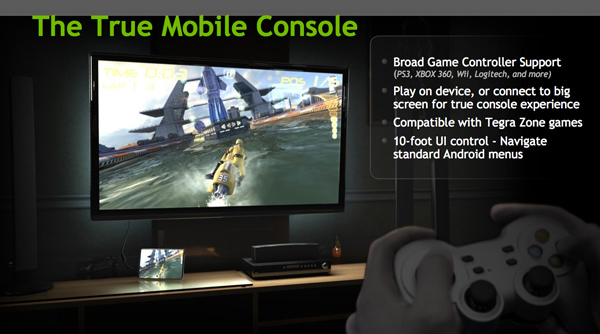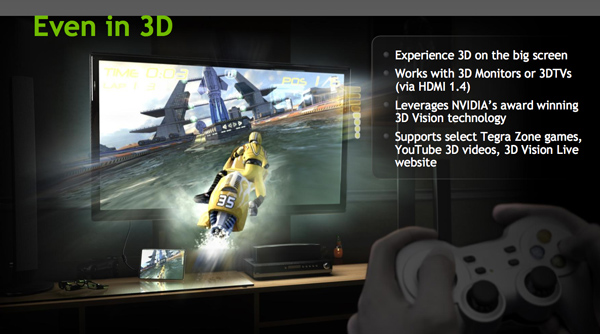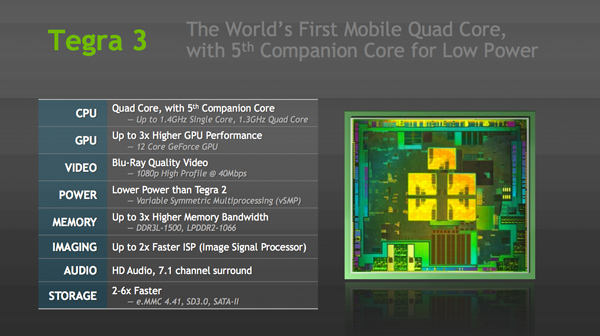NVIDIA's Tegra 3 Launched: Architecture Revealed
by Anand Lal Shimpi on November 9, 2011 12:34 AM ESTThe Tegra 3 GPU: 2x Pixel Shader Hardware of Tegra 2
Tegra 3's GPU is very much an evolution of what we saw in Tegra 2. The GeForce in Tegra 2 featured four pixel shader units and four vertex shader units; in Tegra 3 the number of pixel shader units doubles while the vertex processors remain unchanged. This brings Tegra 3's GPU core count up to 12. NVIDIA still hasn't embraced a unified architecture, but given how closely it's mimicking the evolution of its PC GPUs I wouldn't expect such a move until the next-gen architecture - possibly in Wayne.
| Mobile SoC GPU Comparison | |||||||||||
| Adreno 225 | PowerVR SGX 540 | PowerVR SGX 543 | PowerVR SGX 543MP2 | Mali-400 MP4 | GeForce ULP | Kal-El GeForce | |||||
| SIMD Name | - | USSE | USSE2 | USSE2 | Core | Core | Core | ||||
| # of SIMDs | 8 | 4 | 4 | 8 | 4 + 1 | 8 | 12 | ||||
| MADs per SIMD | 4 | 2 | 4 | 4 | 4 / 2 | 1 | 1 | ||||
| Total MADs | 32 | 8 | 16 | 32 | 18 | 8 | 12 | ||||
| GFLOPS @ 200MHz | 12.8 GFLOPS | 3.2 GFLOPS | 6.4 GFLOPS | 12.8 GFLOPS | 7.2 GFLOPS | 3.2 GFLOPS | 4.8 GFLOPS | ||||
| GFLOPS @ 300MHz | 19.2 GFLOPS | 4.8 GFLOPS | 9.6 GFLOPS | 19.2 GFLOPS | 10.8 GFLOPS | 4.8 GFLOPS | 7.2 GFLOPS | ||||
Per core performance has improved a bit. NVIDIA worked on timing of critical paths through the GPU's execution units to help it run at higher clock speeds. NVIDIA wouldn't confirm the target clock for Tegra 3's GPU other than to say it was higher than Tegra 2's 300MHz. Peak floating point throughput per core is unchanged (one MAD per clock), but each core should be more efficient thanks to larger caches in the design.
A combination of these improvements as well as newer drivers are what give Tegra 3's GPU its 2x - 3x performance advantage over Tegra 2 despite only a 50% increase in overall execution resources. In pixel shader bound scenarios, there's an effective doubling of execution horsepower so the 2x gains are more believable there. I don't expect many games will be vertex processing bound so the lack of significant improvement there shouldn't be a big issue for Tegra 3.
Ready for Gaming: Stereoscopic 3D and Expanded Controller Support
Tegra 3 now supports stereoscopic 3D for displaying content from YouTube, NVIDIA's own 3D Vision Live website and some Tegra Zone games. In its port of Android, NVIDIA has also added expanded controller support for PS3, Xbox 360 and Wii controllers among others.

Tegra 3 Video Encoding/Decoding and ISP
There's unfortunately not too much to go on here, especially not until we have some testable hardware in hand, but NVIDIA is claiming a much improved video decoder and more efficient video encoder in Tegra 3.
Tegra 3's video decoder can accelerate 1080p H.264 high profile content at up to 40Mbps, although device vendors can impose their own bitrate caps and file limitations on the silicon. NVIDIA wouldn't go into greater detail as to what's changed since Tegra 2, other than to say that the video decoder is more efficient. The video encoder is capable of 1080p H.264 base profile encode at 30 fps.
The Image Signal Processor (ISP) in Tegra 3 is twice as fast as what was in Tegra 2 and NVIDIA promised more details would be forthcoming (likely alongside the first Tegra 3 smartphone announcements).
Memory Interface: Still Single Channel, DDR3L-1500 Supported
Tegra 3 supports higher frequency memories than Tegra 2 did, but the memory controller itself is mostly unchanged from the previous design. While Tegra 2 supported LPDDR2 at data rates of up to 600MHz, Tegra 3 increases that to LPDDR2-1066 and DDR3-L is supported at data rates of up to 1500MHz. The memory interface is still only 32-bits wide, resulting in far less theoretical bandwidth than Apple's A5, Samsung's Exynos 4210, TI's OMAP 4, or Qualcomm's upcoming MSM8960. This is particularly concerning given the increase in core count as well as GPU execution resources. NVIDIA doesn't expect memory bandwidth to be a limitation, but I can't see how that wouldn't be the case in 3D games. Perhaps it's a good thing that Infinity Blade doesn't yet exist for Android.
SATA II Controller: On Die
Given Tegra 3 will find itself in convertible Windows 8 tablets, this next feature makes a lot of sense. NVIDIA's latest SoC includes an on-die SATA II controller, a feature that wasn't present on Tegra 2.












94 Comments
View All Comments
dagamer34 - Wednesday, November 9, 2011 - link
Technically Sony's been planning on having 4 Cortex A9 CPUs inside the Playstation Vita since it was announced in January (plus the very powerful PowerVR SGX 543MP4)Klinky1984 - Wednesday, November 9, 2011 - link
...and where might I obtain a Playstation Vita? What other four core ARM chip is available in mainstream products as of today?Klinky1984 - Wednesday, November 9, 2011 - link
Maybe I should I have phrased that as "available for use in mainstream products as of today", I don't think Sony is going to let anyone use their SoC in a phone or tablet.MrMilli - Wednesday, November 9, 2011 - link
Both NEC (now Renesas Electronics) and Marvell beat nVidia to it. NEC focuses more on the industrial side of things and Marvell (Armada XP) more on storage/server applications. But NEC chips often find their way into automotive electronics (I believe some GPS systems use their ARM11 quad core from years ago).I don't know what you see as a mainstream products. But GPS systems and low-end servers can be seen as mainstream.
Klinky1984 - Wednesday, November 9, 2011 - link
Enterprise, industrial & embedded products are not mainstream. The Tegra3 is going to be a selling point for the products that use it & those products will be advertised prominently on the TV, print & the Internet. I highly doubt you'll see that for the chips you mentioned, I don't think I've ever seen a car commercial tout that their GPS is powered by NEC or Marvell or whatever platform they're using. I've seen plenty of phone commercials touting Tegra2 or Snapdragon.Stuka87 - Wednesday, November 9, 2011 - link
I disagree, and I am not sure you are aware of the meaning of mainstream. As its all dependent on point of view.Mainstream is something which is purchased, used or accepted broadly rather than by a tiny fraction of population or market; common, usual or conventional.
-Wikipedia
Nowhere is it stated that something has to be on TV to be mainstream. It simply has to be popular in the market that it is aimed at. And NEC is most definitely mainstream in the markets that they target.
eddman - Wednesday, November 9, 2011 - link
But the question was: can you buy a phone or tablet with an NEC or marvell quad-core SoC?Maybe Tegra 3 wasn't the first quad ARM chip, but it is the first quad for mobile devices.
TI doesn't have any in its roadmap for now.
Same thing for St-Ericsson as TI.
Qualcomm's quads won't appear until Q4 2012.
Samsung hasn't announced any yet.
Stuka87 - Wednesday, November 9, 2011 - link
This is true. The NEC would not be suitable for a mobile device, and is not available for them. So nVidia is first in that market space.Penti - Sunday, November 20, 2011 - link
Renesas do offer quad-core mobile cpus. As does any one else, it's just a matter off when they are actually available. They do have an more impressive overall offer in the mobile space though.Klinky1984 - Thursday, November 10, 2011 - link
Almost 1/3rd of the US population has a smartphone, how many of those consumers have an enterprise NAS, SAN or ARM based cloud server or even know what one is & even if they do know what one is do they actually have a desire to buy one? As for embedded GPS devices, which devices used the prototype quad-core ARM11 from Renesas Electronics?Additionally I am not finding actual products containing a Marvell Armada XP or Renesas Electronics R-Car H1, The R-Car H1 doesn't even start mass production until almost 2013. Renesas Electronics' Quad ARM11 NaviEngine looks like it was used by Alpine Car Information Systems in 2010, but finding out what Alpine product uses it & where I could buy it is a challenge.